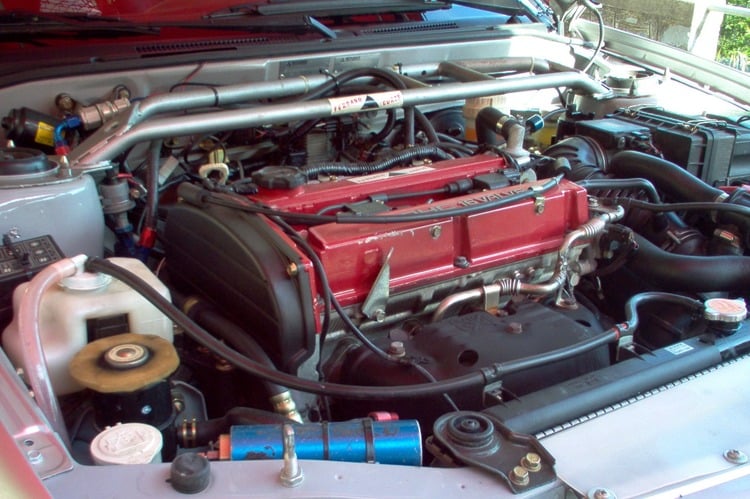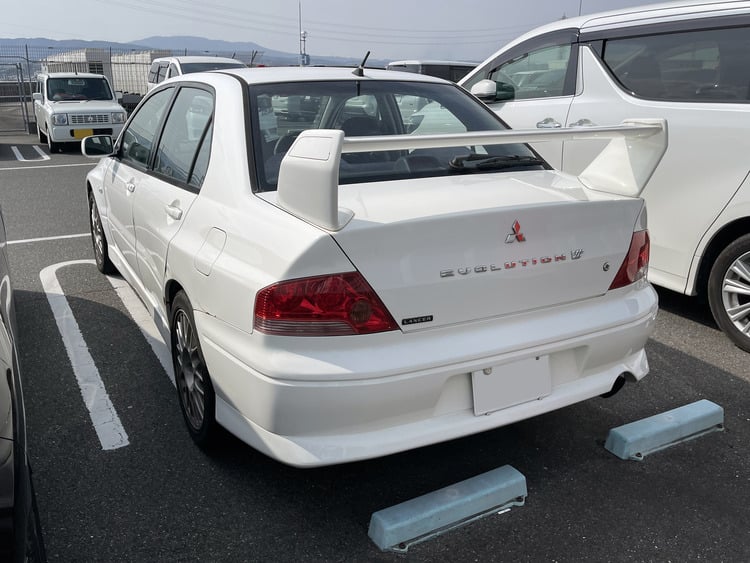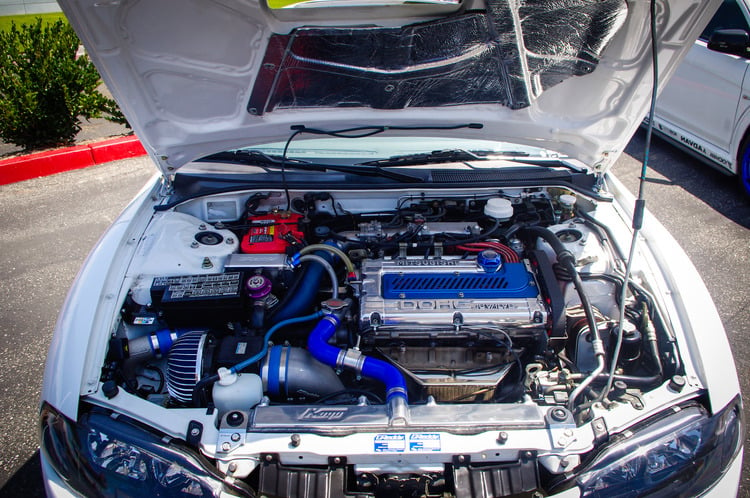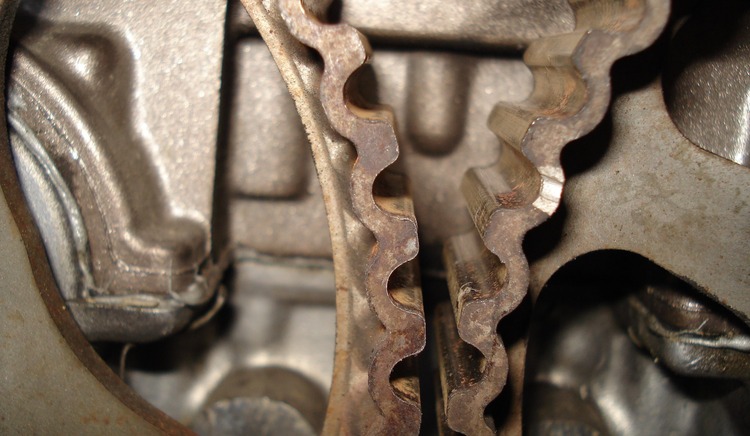Mitsubishi Evolution VII – A Rally Legend
Some may think the Mitsubishi Lancer Evolution VII looks like a kid’s project car, but this Mitsubishi is the 427 Corvette for the PlayStation generation.

Jump To Section
Introduction
Mitsubishi Motors started the production of Lancer Evolution VII in 2001. The car was built on the bigger Lancer Cedia chassis, a bigger, more advanced car than the Lancers on which the prior Evos were based. Evo VII followed the design philosophy identical to earlier Lancer Evos.
The Evo VII versions that followed had increased power figures and other drivetrain changes. The Evo VII included the active center differential for the first time. Evo VII offered an automatic transmission for specific regions and also came with Mitsubishi’s Sirius engine, the 4G63T, providing the ultimate tuner platform.
Mitsubishi Evo History
The Lancer Evolution made its debut in October 1992. The compact and lightweight Lancer was powered by a Mitsubishi Motors 4G63 turbocharged engine. Together with its 4WD powertrain, it produced outstanding torque figures, making it one of the best AWD cars on the market.

The Mitsubishi Lancer Evolution’s reputation has grown due to several significant advancements made over the years in its engine, performance, body rigidity, lightweight, suspension refinement, and aerodynamics.
On January 31, 2003, Mitsubishi Motors Corporation introduced Japan’s Evolution VIII sports sedan.
Since the 1992 debut of the most popular Evolution models, Mitsubishi has produced eight further generations.
Evo 7 Specifications
The Mitsubishi Evo VII was the first to come equipped with a limited-slip and active center differential.
The 5-speed automatics had what Mitsubishi called “fuzzy logic.”
Upshift and downshift points were determined by fuzzy logic using a set of upshift and downshift values, as well as rules for weighting each value in line with the degree to which acceleration and throttle position are members of functions.
This was done based on the driver’s driving, accelerating, and gear-shifting styles.
Based on Cedia’s CT9A platform, the Evo VII was powered by a 2.0 L Inline 4 turbocharged engine. The total curb weight was between 1310 and 1400 kg. The car had a wheelbase of 2625 mm, while it measured 4455 mm in length, 1770 mm in width, and 1450 mm in height for all its variants.
Powertrain
The Mitsubishi Lancer Evolution VII was powered by the 2.0-liter inline-four turbocharged 4G63t engine, capable of producing 276 horsepower and 273 lb-ft of torque, thus a top speed of 140 mph, which was more than enough.
The 4G63 engine featured a cast iron block and aluminum head, with DOHC 16-valve design and MIVEC variable valve timing. This engine was capable of revving to 8000 RPM, giving the Lancer Evolution VII excellent throttle response and high-end power.

The engine was mated to a five-speed manual transmission, transmitting power to the all-wheel drive system.
The all-wheel-drive system was designed to give the Lancer Evolution VII excellent grip in a variety of conditions and was able to distribute torque to the wheels that needed it the most. This helped the car maintain stability and traction, even in challenging driving conditions.
The 4G63 engine was known for its reliability, making it an ideal choice for rally and motorsport enthusiasts.
The engine was also highly tunable, with many aftermarket parts available to further improve its performance.
The Mitsubishi Lancer Evolution VII was a true driver’s car, with a balanced chassis and sharp handling made it a joy to drive on both road and track. Overall, the 4G63 engine was an essential part of what made the Lancer Evolution VII a genuinely great car.
Evo 7 Variants
Evo VII came in three different variants. All variants offered the exact power figures and the same 5-speed automatic or manual transmission. The RS or rally-sport variant had some salient features, including rally suspension, bucket seats, limited slip differential, and a sports anti-lock braking system.
The GSR variant came with enhanced braking, using Brembo brakes and sports ABS, and little tweaks in the interior, including bucket seats and a sports steering wheel.

GT-A came with a 5-speed F5A5 automatic transmission. This automatic model came with a premium interior trim level of full leather seats or Recaro sports seats. This was the only variant with 17-inch alloy wheels with a diamond-cut finish.
The FQ-300 was a top-of-the-line model in the EVO 7 lineup, and it was powered by a 2.0-liter turbocharged 4-cylinder engine that produced 300 horsepower and 305 lb-ft of torque.
This engine was paired with a 5-speed manual transmission and an all-wheel-drive system, providing excellent traction and handling on dry and wet roads.
In terms of performance, the FQ-300 could accelerate from 0-60mph in just over 4 seconds and reach a top speed of around 155 mph, limited, as per USA regulation.
The car was also equipped with high-performance brakes and a sport-tuned suspension, which made it a joy to drive on winding roads.
The exterior of the FQ-300 was designed to be aerodynamic and aggressive, with sharp lines and a distinctive front fascia. The interior was also well-appointed, with comfortable sports seats and a high-quality sound system on the dashboard.
Evo VII gained so much popularity globally because it was the first of a brand-new breed of Evos that made an appearance in the WRC. Known as the WRC Lancer, the ultimate model that Mitsubishi and its tuning arm RALLIART went all out for.

In the eleventh round of the World Rally Championship, Rallye Sanremo, in October 2001, the Lancer WRC debuted. For their final season of WRC in 2005, Mitsubishi went all in for the Lancer WRC05.
The WRC Lancer was a race-only vehicle. The dry sump oiling system, block main girdle, and some of the crucial internal parts were among the few components not shared with the Lancer Evolution VII production models.
The WRC Lancer was perhaps one of the most popular models ever made, but unfortunately, this wasn’t a road-going model.
Evo 7 Mods, Upgrades, and Tuning
The 4G63t engine has a good reputation for being reliable and highly tunable. Some common engine upgrades and tunings for this engine include the installation of a larger or upgraded turbocharger that can increase the engine’s horsepower and torque.
All stock 4G36t turbos have an internal wastegate controlled by a flapper door. The wastegate exits into a separate port in the exhaust turbine housing, from where it must be merged into the rest of the exhaust system. It’s a sound, reliable system that is preferred for most street cars.
The Evo’s turbo maintains a separate flow for the wastegate valve from the manifold out to the Oxygen housing. This keeps the gasses from impinging on the flow out of the turbine, increasing efficiency and flow. You’re much less likely to get boost creep with the Evo turbine than with the DSM turbine.
You might want to consider an external wastegate for many reasons if you’re building a high-horsepower DSM or Evo.
For one thing, the wastegate valve is much larger than the stock internal wastegate, meaning boost pressure can be held closer to the set point with less wastegate operation.
For another, the wastegate outlet doesn’t affect the flow out of (and therefore through) the exhaust turbine.
Careful porting can help you avoid boost creep in some cases. However, you’ll need a steady hand to pull this off since a slip could cause the wastegate valve to leak exhaust and slow spool.
This particular turbo also has a larger flapper valve installed, which is trickier than porting the wastegate opening.
You can easily use the stock turbine housing with an external wastegate; block the stock wastegate port on the outlet side.
The cleanest solution is to weld a flat disk over the wastegate area, but you could also wire the stock wastegate flapper closed.
Further mods include installing a larger or more efficient intercooler to reduce air temperature, and increasing engine performance and reliability.
An aftermarket engine management system can also be installed to improve engine tuning and provide more precise control over the engine’s performance.

Camshafts can also be upgraded on these cars to increase the engine’s power by optimizing valve lift and duration.
The fuel system upgrades include enhanced fuel injectors, fuel pumps, and fuel pressure regulators that can provide more fuel to the engine, increasing horsepower and torque but decreasing the car’s economy.
If that is a huge tradeoff, then a simple upgrade with the pistons and rods can increase engine strength and reliability and result in the longer life of the car.
These upgrades can significantly improve the engine’s performance, but it is important to note that not all upgrades will be compatible.
Researching and consulting with a professional tuner before making any engine modifications is recommended to ensure that the upgrades are done correctly and do not negatively impact the engine’s reliability.
Evo 7 Reliability & Common Issues
Perhaps the owners of these vehicles with dependability concerns do not fully understand how to maintain these monstrosities.
If ignored, the 4G63t engine suffers significantly and will not endure repeated abuse. Any turbocharged DOHC engine needs regular oil changes and timing belt replacement to function correctly.
Broken valves, even with mileage as low as 60,000 miles, are one of the 4G63t engine’s most prevalently reported issues.
If the oil is not changed regularly enough, this occurs more frequently, although they typically fail after 120K miles and emit smoke when malfunctioning.
The most recent parts offered by your local Mitsubishi dealer are far higher quality than the original seals and last much longer.
Any turbo engine’s blue smoke from the exhaust should be examined first. High-mileage engines frequently experience oil burning, primarily caused by worn valve stem seals.
The head might need to be disassembled or possibly replaced, but the valve stem seal is fantastic since it can be replaced with relative ease.
In general, it is a good idea in the case of the 4G63t to replace other worn-out parts.
Another potential source of oil in the combustion chambers is the turbo. Most 4G63t engines have a top-notch Mitsubishi turbocharger with a water-cooled middle section.
A turbo may even operate faultlessly for up to 150 000 miles with the proper maintenance, which includes frequent oil changes, but if the engine’s upkeep is neglected, issues are certain. A malfunctioning turbo may produce smoke when accelerating or, worst case, a scraping noise when a boost is applied.
If the turbo makes the engine burns much oil, replacement is advised.

Ring wear is another factor in oil burning. This issue usually arises after the engine has traveled more than 200,000 kilometers or beyond that. If this issue occurs, you will unavoidably need to remove the engine and replace the bottom end.
Climate control-related odors are a common issue in these vehicles. The evaporator drain hole may be blocked if you notice an unpleasant or fishy smell when the air conditioner is turned on. To fix this smell, you must clear the evaporator drain hole.
This generation of the Evo also has problems with its engine running on idle. Like on one of the recent 3-cylinder JDM cars, the idling rpm of this car should ideally be just under 1000 with the fan or air conditioning on.
If the rpm goes higher, there is some problem with the idle control valve, which may indicate its possible failure.
The first step to solve this problem is to remove and clean the idle control valve. If this isn’t enough, replacement is recommended. The actuator is known to fail on Evo VII.
The actuator might be faulty if the car has sudden boosts or jolts after a slight power loss at high revs.
You will need to find a replacement actuator to resolve the issue.
Conclusion
Growing up, I found myself fond of the Evo VII because of its appearance in the movie 2 Fast 2 Furious as Paul Walker’s ride in its attractive yellow paint scheme. The Evo VII undoubtedly gained popularity after that appearance, making people want to buy one of these 4G63t-powered cars.
Generally, these cars have buyers who want to use them to their fullest potential, maybe adding some tunes and mods to the powertrain. Evo VII was succeeded by the Evo VIII.
If you ever buy one of these cars, you must examine it closely before making a purchase. If the car is kept clean, it will likely be in good mechanical condition as well. Finding the straightest body is another priority, as bodywork can get expensive for these cars.
















